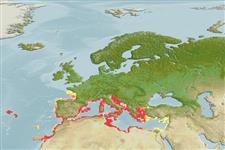Common names from other countries
Environment: milieu / climate zone / depth range / distribution range
Ekologi
; kisaran kedalaman 1 - 100 m (Ref. 105991). Subtropical; 49°N - 27°N, 19°W - 36°E
Eastern Atlantic and Mediterranean: from France to Spain, Portugal, Morocco, Madeira Island and Canary Islands, including the Mediterranean.
Length at first maturity / Size / Weight / umur
Maturity: Lm ? range ? - ? cm Max length : 8.3 cm SHL jantan/; (Ref. 123052); Berat maksimum terpublikasi: 58.20 g (Ref. 123052)
Intertidal to a depth of 80 m. Found in a lagoon (Ref. 105976). Also found offshore (Ref. 122927). Inhabits rocky, sandy-mud and mud substrata (Ref. 105992). Also found on seagrass (Ref. 85545). Opportunistic feeder, exhibiting both carnivory and scavenging. Feeds on a variety of bivalves, including gastropods, barnacles, tunicates, bryozoans, carrion and its conspecifics. Employs drilling and chipping patterns on certain bivalves (Ref. 106099).
Life cycle and mating behavior
Kematangan | Reproduksi, perkembang biakan | Pemijahan | telur-telur | Fecundity | Larva
This species is a non-broadcast spawner. Life cycle does not include trocophore stage. Also Ref. 833.
rujukan utama
Acuan | Koordinator | mitra
Templado, J. and R. Villanueva. 2010. (Ref. 85339)
Status IUCN Red List (Ref. 130435)
status CITES (Ref. 108899)
Not Evaluated
Not Evaluated
ancaman kepada manusia
Harmless
penggunaan manusia
Perikanan: komersial
| FishSource |
Alat, peralatan
informasi lanjut
Umur / SaizPertumbuhanpanjang-beratpanjang-panjangMorfologiLarvaKelimpahan
Sumber internet
Estimates based on models
Preferred temperature
(Ref.
115969): 14.5 - 21.5, mean 18.7 (based on 202 cells).
